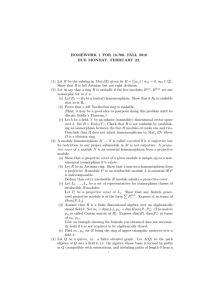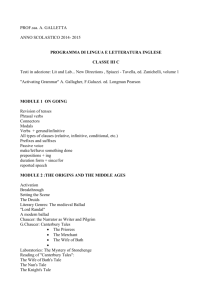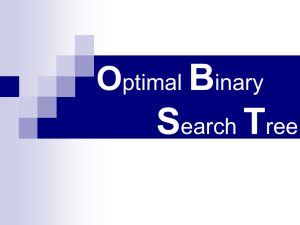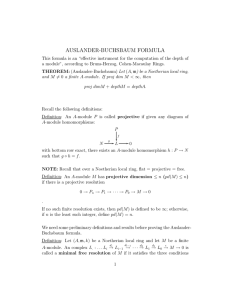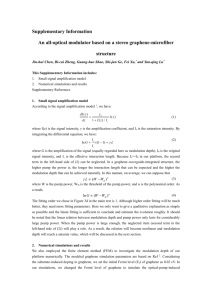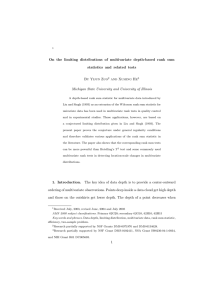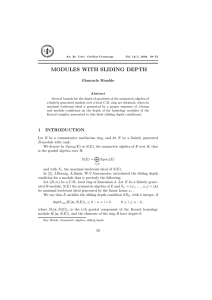SYZYGIETIC PROPERTIES OF A MODULE AND TORSION FREENESS OF ITS SYMMETRIC POWERS
advertisement
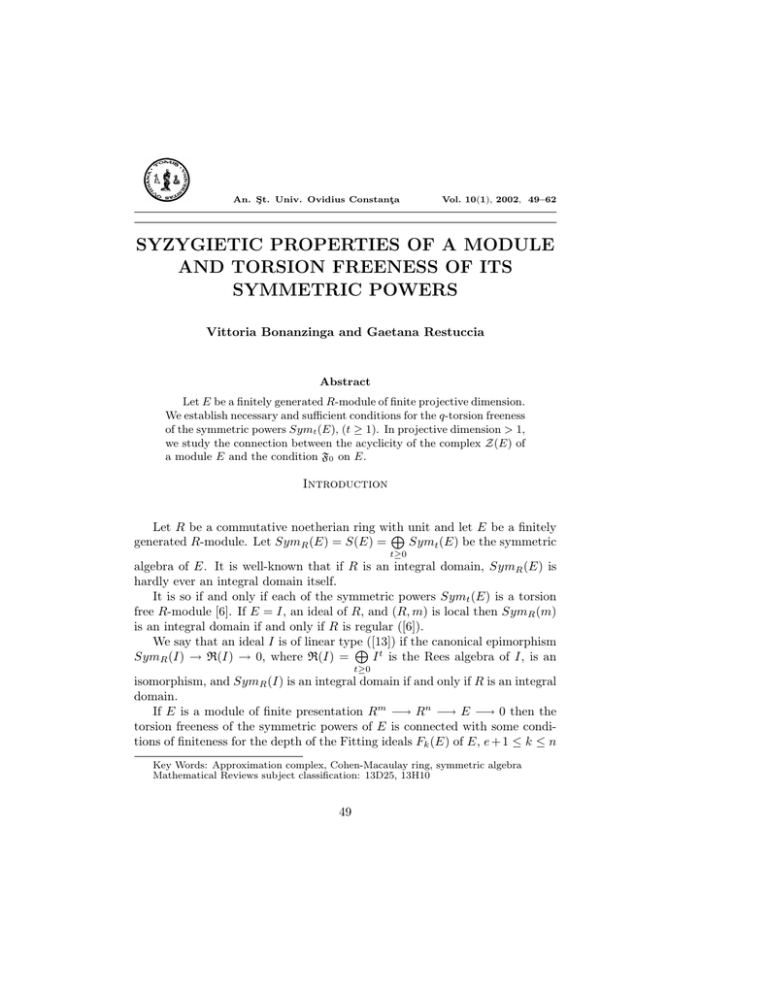
An. Şt. Univ. Ovidius Constanţa
Vol. 10(1), 2002, 49–62
SYZYGIETIC PROPERTIES OF A MODULE
AND TORSION FREENESS OF ITS
SYMMETRIC POWERS
Vittoria Bonanzinga and Gaetana Restuccia
Abstract
Let E be a finitely generated R-module of finite projective dimension.
We establish necessary and sufficient conditions for the q-torsion freeness
of the symmetric powers Symt (E), (t ≥ 1). In projective dimension > 1,
we study the connection between the acyclicity of the complex Z(E) of
a module E and the condition F0 on E.
Introduction
Let R be a commutative noetherian ring with
L unit and let E be a finitely
Symt (E) be the symmetric
generated R-module. Let SymR (E) = S(E) =
t≥0
algebra of E. It is well-known that if R is an integral domain, SymR (E) is
hardly ever an integral domain itself.
It is so if and only if each of the symmetric powers Symt (E) is a torsion
free R-module [6]. If E = I, an ideal of R, and (R, m) is local then SymR (m)
is an integral domain if and only if R is regular ([6]).
We say that an ideal I is of linear type
if the canonical epimorphism
L([13])
I t is the Rees algebra of I, is an
SymR (I) → R(I) → 0, where R(I) =
t≥0
isomorphism, and SymR (I) is an integral domain if and only if R is an integral
domain.
If E is a module of finite presentation Rm −→ Rn −→ E −→ 0 then the
torsion freeness of the symmetric powers of E is connected with some conditions of finiteness for the depth of the Fitting ideals Fk (E) of E, e + 1 ≤ k ≤ n
Key Words: Approximation complex, Cohen-Macaulay ring, symmetric algebra
Mathematical Reviews subject classification: 13D25, 13H10
49
50
V. Bonanzinga and G. Restuccia
when the module E admits rank e > 0. Consequently, we can deduce theoretic
properties of the symmetric algebra SymR (E) by the syzygetic properties of
the module E.
It is interesting to investigate the q-torsion freeness of the symmetric powers of E, by using acyclicity criteria for canonical complexes associated to the
symmetric algebra of E.
In projective dimension 1, the basic result of Avramov [2] solves the problem completely, in the sense, that, for each t, Symt (E) is q-torsion free if and
only if E is Fq := depth(Fk (E)) > k − e + q, e + 1 ≤ k ≤ n .
In section 1, we consider modules of finite projective dimension and we
establish necessary and sufficient conditions for the q-torsion freeness of the
symmetric powers Symt (E) (t > 1).
In section 2, we examine the relation between the acyclicity of the Z(E)complex of a module E and the condition F0 on E, when the Z(E)-complex
coincides with the Koszul complex of the immersion 0 −→ L −→ Rn , with
0 −→ L −→ Rn −→ E a finite presentation of E and L not necessarily free.
1
We consider a module E of finite projective dimension with the following free
resolution
F. :
fs
fs−1
f1
0 −→ Fs −→ Fs−1 −→ . . . −→ F0 −→ E −→ 0
(1)
with Fi , free R-modules.
By theorem 2.1 [11] we can associate to E a canonical complex Si (F.). The
goal of this section is to use this canonical complex in order to study when the
symmetric powers of E are q-torsion free (q > 1).
We recall that a module E is called q-torsion free if every R-regular sequence of lenght q is also E-regular.
Proposition 1 Let E be a module of finite projective dimension over a noetherian ring R and let q be an integer. The following are equivalent:
1. E is q-torsion free.
2. For every prime ideal ℘ of R, depth(E℘ ) ≥ min(q, depth(R℘ ))
3. E is a q-th syzygy.
Proof. See [1], [2].
Syzygietic properties of a module and torsion freeness
51
Remark 1 In general, for an arbitrary module E, we have only the implications 3) ⇒ 2) ⇒ 1). We have also the equivalence for arbitrary modules if
R is a normal domain and q ≤ 2 ([10], prop. 1). In this case and in finite
projective dimension, the 2-torsion free modules are the reflexive ones.
Let E be a module generated by n elements. For the next theorem we
switch from determinantal ideals to Fitting invariants Fk (E) = In−k+1 (f1 ),
where In−k+1 (f1 ) denotes the ideal generated by the n − k + 1-sized minors
of f1 .
We say that a module E has rank e if E ⊗R Q(R) is a free Q(R)-module
of rank e, where Q(R) the total quotient ring of R.
Theorem 2 Let E be a module of projective dimension 2 over a noetherian
ring R, of rank r and with resolution
f2
F. :
f1
0 −→ F2 −→ F1 −→ F0 −→ E −→ 0
(2)
where F2 , F1 , F0 are free R-modules of rank p, m, and n, respectively. Suppose
that E is 2(i − 1) + q-torsion free, (q ≥ 1), i ≥ 2; i! is invertible in R. Then
we have:
1. Symi (E) is q-torsion free
2. depth Fk (E) ≥ k − r + q, r + 1 ≤ k ≤ n.
Proof. It suffices to observe that the complex Si (F.) associated to E, of
theorem 2.1 [11], is acyclic, and by Corollary [14] Symi (E) is q-torsion free,
hence 1).
Since E is 2(i − 1) + q−torsion free, there exists an exact sequence
0 −→ E −→ G1 −→ · · · −→ G2(i−1)+q
with Gj −free of finite type.
Then the sequence (2) is extendable to the right by an exact sequence in
this way:
f2
f1
0 −→ F2 −→ F1 −→ F0 −→ E −→ G1 −→ · · · −→ G2(i−1)+q .
By Buchsbaum-Eisenbud criterion we must necessarily have depth(Ir1 (f1 )) ≥
2(i − 1) + q + 1, where r1 = rank Im f1 = m − p. But Ik (f1 ) ⊇ Ir1 (f1 ), ∀k ≤ r1 ,
then depth(Ik (f1 )) ≥ depth(Ir1 (f1 )), ∀k ≤ r1 .
52
V. Bonanzinga and G. Restuccia
In particular depth(Ir1 −i+1 (f1 )) ≥ 2i + q − 1 > i + q − 1 ≥ i + q; if we put
r1 − i + 1 = k, then
depth(Ik (f1 )) > r1 − k + q + 1
hence 2).
Theorem 3 Let E be a module of projective dimension 2 over a noetherian
ring R, of rank r and with resolution (2), with depth Ip (f2 ) ≥ m − p − 1. Let
q be an integer, q ≥ 1 and let i be an integer ≥ 2; such that 2i < m − p; i! is
invertible in R. We suppose that:
depth Fk (E) ≥ k − r + q,
r + 1 ≤ k ≤ n.
Then Symi (E) is q − torsion f ree.
Proof. It follows by [1.9, 11] that
pdR (Symi (E)) ≤ 2i
∀i > 0.
Then, if ℘ is a prime ideal such that depth(R℘ ) ≥ 2i + q, we have:
depth(Symi (E)℘ )
= depth(R℘ ) − pdR℘ (Symi (E)℘ ) ≥
≥ 2i + q − pdR℘ (Symi (E)℘ ) ≥ 2i + q − 2i = q.
Now, we consider a prime ideal ℘ such that
depth(R℘ ) < 2i + q.
By hypothesis, depth(I1 (f1 )) ≥ (m − p) + q > 2i + q and we have that I1 (f1 ) *
℘. It follows that the module E℘ admits a free resolution over R℘
f0
1
0 −→ F20 −→ F10 −→
F00 −→ E℘ −→ 0
m−1
m
n−1
n
⊕ R℘
= R℘
⊕ R℘ , F10 = R℘
= R℘
with F00 = R℘
Ik−1 (f10 ) = Ik (f1 )℘ , we have the inequalities
depth(Ik−1 (f10 )) ≥ (m − 1) − p − (k − 1) + 1 + q,
Moreover, since
for 1 ≤ k − 1 ≤ (m − 1) − p
We can then apply the induction on m. In fact, if m = 0, E is free and the
result is trivial. By induction, then we can conclude that
depth (Symi (E)℘ ) ≥ min(q, depth(R℘ )).
53
Syzygietic properties of a module and torsion freeness
Corollary 4 Let E be a module of projective dimension 2 over a noetherian
ring R, 2(i − 1) + q-torsion free of rank r and with resolution (2). Let q be an
integer ≥ 1 and let i be an integer ≥ 2; such that 2i < m − p; i! is invertible
in R. Then the following conditions are equivalent:
1. depth (Fk (E)) ≥ k − r + q,
r+1≤k ≤n
2. Symi (E) is q-torsion free.
We say that a module E satisfies Fq if ht It (f1 ) ≥ rank f1 − t + 1 + q, 1 ≤
t ≤ rank f1 , where q ≥ 0 is an integer and rank f1 = sup{t/It (f1 ) 6= 0}
Theorem 5 Let E be a module of finite type over R, of rank e, generated by
n elements, of finite projective dimension. Let q be an integer, q ≥ 1. We
suppose that:
1. pd R (SymR (E)) ≤ n − e
2. E is Fq .
Then Symt (E) is q − torsion f ree, ∀ t > 0.
Proof. We consider a presentation of the module E
Rm
f1 =(aji )
−→
Rn −→ E −→ 0
(3)
and let
0 −→ L −→ Rn −→ E −→ 0.
We have pdR (Symi (E)) ≤ n − e = ` = rank L ∀ i > 0.
Let ℘ ∈ Spec(R) such that depth (R℘ ) ≥ ` + q. Then
depth (Symi (E)℘ ) = depth (R℘ ) − pdR℘ (Symi (E)℘ ≥ ` + q − ` = q =
min(q, depth(R℘ )).
Let ℘ ∈ Spec(R) such that depth (R℘ ) < ` + q.
By Fq , depth(I1 (f1 )) ≥ ` + q, I1 (f1 ) * ℘ and localizing (3) at the prime
ideal ℘, we have:
f 0 ⊕id
1
m−1
n−1
R℘
⊕ R℘ −→
R℘
⊕ R℘ −→ E℘ −→ 0
and E℘ has the presentation:
0
f0
1
n−1
0 −→ L℘ −→
R℘
−→ E℘ −→ 0
0
0
0
L℘ = L℘ ⊕ R℘ , rank (L℘ ) = rank(L℘ ) − 1 and Ik−1 (f1 ) = Ik (f1 )℘
∀k.
54
V. Bonanzinga and G. Restuccia
We proceed by induction on `.
If ` = 0, E is free and the equivalences are trivial.
By induction hypothesis,
0
depth Ik−1 (f1 ) ≥ ` − k + q + 1 = (` − 1) − (k − 1) + q + 1
where 1 ≤ k − 1 ≤ ` − 1 and it follows
depth (Symi (E)℘ ) ≥ q ≥ min(q, depth(R℘ )).
Remark 2 If R is a Cohen-Macaulay ring and E is a module of finite
type over R of finite projective dimension 1, which is F0 (or, equivalently, if
Symt (E) is torsion free, ∀ t > 0 ), the condition pdR (SymR (E)) ≤ n − e is
always verified. In fact, in this case SymR (E) has a free finite resolution ([5],
Prop. 4.1) of lenght n − e.
Theorem 6 Let E be an R-module of finite type, being R a Cohen-Macaulay
ring, of rank e, of finite projective dimension. Let q ≥ 1 be an integer and we
suppose that:
1. For all prime ideal ℘ of R such that depth (℘R℘ ) > `, depth Ik (f1 )℘ ≥
` − k + q + 1, 1 ≤ k ≤ `;
2. Symt (E) is q-torsion free, ∀ t > 0.
Then E is Fq .
Proof. We proceed by induction on ` = rank L, L = ker(Rm → E).
If ` = 0, the assertion is trivial.
If rank L = `, by theorem 3.1 [9], we have:
depth I1 (f1 ) ≥ `.
Let ℘ ∈ Spec(R) such that depth ℘R℘ ≤ `. Then I1 (f1 ) * ℘ and, localizing
(3) at the prime ideal ℘, we have:
f 0 ⊕id
1
m−1
n−1
R℘
⊕ R℘ −→
R℘
⊕ R℘ −→ E℘ −→ 0
and the presentation:
0
f0
1
n−1
0 −→ L℘ −→
R℘
−→ E℘ −→ 0
0
0
rank (L℘ ) = rank(L℘ )−1 and Ik−1 (f1 ) = Ik (f1 )℘ .
0
By induction hypothesis:
depth Ik−1 (f1 ) ≥ (` − 1) − (k − 1) + q + 1 = ` − k + q + 1.
Syzygietic properties of a module and torsion freeness
55
Since for every prime ideal ℘ ∈ Spec(R), depth Ik (f1 )℘ ≥ ` − k + q + 1, then
we can suppose that R is local and it results that depth Ik (f1 ) ≥ ` − k + q + 1,
1 ≤ k ≤ `, i. e., E is Fq .
2
Let E be a module of finite presentation:
Rm
f1 =(aji )
−→
ϕ
Rn −→ E −→ 0
and let
0 −→ L−→Rn −→ E −→ 0.
If E has rank e, then we have
rank L = ` = n − e.
We introduce the Z-complex, Z(E), of the module E that is a complex of
graded S = S(Rn )-modules:
N
Z(E) :=
0 −→ Zn−e ⊗ S[−`] −→ ... −→ Z1 S[−1] −→ S −→
SymR (E) −→ 0,
i
i−1
V
V n
∂
Zi = Zi (E) = ker( Rn −→
R ⊗ E), ∂(a1 ∧ . . . ∧ ai ) =
P where
(−1)j (a1 ∧ . . . ∧ abj ∧ . . . ∧ ai ) ⊗ ϕ(aj ), S[−j]r = Sr−j .
We consider the case when the complex Z(E) coincides with the Koszul
complex of immersion 0 −→ L −→ Rn
`−1
V̀
V
N
S(L.) := 0 −→ L⊗S[−`] −→
L⊗S[−`+1] −→ ... −→ L S[−1] −→
S −→ SymR (E) −→ 0.
We need some preparatory lemmas
Lemma 7 Let F be a module of finite type over R, not necessarily free. Let
M
M
SR (F ) =
Symi (F ) =
Si (F )
i≥0
be the symmetric algebra of F and
i≥0
V
F =
i
LV
i≥0
Then we have:
1. Si (F
L
R) ∼
=
i
L
j=0
Sj (F );
F the exterior algebra of F .
56
V. Bonanzinga and G. Restuccia
2.
i
V
(F
L
R) ∼
=
i
V
F
L i−1
V
F
Proof. For F free see lemma 3 [12], lemma 2 [14].
1. If F is not free, we consider a presentation of F :
f
0 −→ L −→ R n −→ F −→ 0
and the induced exact sequence:
n
0 −→ J −→ S (R ) −→ S (F ) −→ 0 .
We have
f ⊕id
0 −→ L −→ R n ⊕R −→ F ⊕ R −→ 0 ,
and the induced exact sequence
n
0 −→ J −→ S (R ⊕R) −→ S (F ⊕ R) −→ 0
n
0 −→ J i −→ S i (R ⊕R) −→ S i (F ⊕ R) −→ 0
i
L
where Ji = J ∩ Si (Rn ⊕ R). Since Si (Rn ⊕ R) =
Sj (Rn ), Ji = J ∩
j=0
Ã
!
i
i
i
L
L
L
n
Sj (R ) =
Jj . Hence Si (F ⊕R) ∼
Sj (Rn )/Jj ∼
= Si (Rn ⊕R)/Ji ∼
=
=
j=0
i
L
j=0
j=0
j=0
Sj (F ).
f
2. We consider the presentation 0 −→ L −→ R n −→ F −→ 0
f ⊕id
0 −→ L −→ R n ⊕R −→ F ⊕ R −→ 0 the induced exact sequence:
0 −→ B −→
^
(R n ⊕ R)−→
and by
^
(F ⊕ R)−→0
i
i
^
^
n
0 −→ B i −→ (R ⊕ R)−→ (F ⊕ R)−→0
Vi n
Vi
Vi−1 n
where Bi = B ∩
(R ⊕R) = B ∩ ( R n ⊕
R ).
i
Vi
V
V
V
V
L i−1
V
i
n
i
i−1
Hence
(F ⊕ R) ∼
(R ⊕R)/B i ∼
R n /B i ∼
F.
=
= Rn ⊕
= F
57
Syzygietic properties of a module and torsion freeness
f1
Lemma 8 Let E be a module of finite type on R and let K. := 0 −→ L −→
f1 ⊕idR
F0 −→ E −→ 0; K 0 . := 0 −→ L ⊕ R −→ F0 ⊕ R −→ E −→ 0 be
two presentations of E, L not necessarily free, F0 free on R. Then the Koszul
f1
f1 ⊕idR
complexes S(L.) and S(L.0 ) of immersion 0 −→ L −→ F0 , 0 −→ L ⊕ R −→
F0 ⊕ R −→ E have the same homology.
Proof. If we call S(L.) and S(L.0 ) the two Koszul complexes of immersions
0 −→ L −→ F0 , 0 −→ L0 −→ F0 ⊕ R, L0 = L ⊕ R, in the component of degree
t > 0, we have:
St (L.) :=
St (L.0 ) :=
... −→
... −→
i
^
i
^
L ⊗ St−i (F0 ) −→
L0 ⊗ St−i (F0 ⊕ R) −→
i−1
^
i−1
^
L ⊗ St−i+1 (F0 ) −→ ...
L0 ⊗ St−i+1 (F0 ⊕ R) −→ ...
Let:
(St (L.))i =
i
^
L ⊗ St−i (F0 ) and (St (L.0 ))i =
i
^
L0 ⊗ St−i (F0 ⊕ R).
From lemma 7, we have:
i
V
(St (L0 .))i = (L ⊕ R) ⊗ St−i (F0 ⊕ R) ∼
=
µi
¶
i−1
V
V
∼
L⊕
L ⊗ (St−i (F0 ) ⊕ St−i−1 (F0 ) ⊕ ... ⊕ F0 ⊕ R) =
=
= (St (L.)i ⊕ St−1 (L.)i ⊕ ... ⊕ Si+1 (L.)i ⊕ Si (L.)i ) ⊕
⊕ (St−1 (L.)i−1 ⊕ St−2 (L.)i−1 ⊕ ... ⊕ Si (L.)i−1 ⊕ Si−1 (L.)i−1 ).
We proceed in a similar way to that contained in [12] or [14], prop. 3, and
we can conclude that S(L.) and S(L.0 ) have the same homology.
Theorem 9 Let E be a torsion free module of finite type on R, CohenMacaulay ring of finite projective dimension, of rank e and with resolution:
f1
0 −→ Rp −→ ... −→ Rm −→ Rn −→ E −→ 0.
(4)
We suppose that:
1. E is F0 ;
2. If 0 −→ L −→ Rn −→ E −→ 0, ` = rank L, the complex S(L.) is exact
⇐⇒ S(L.) ⊗ R℘ is exact, for all ℘ ∈ Spec(R) such that depth(℘R℘ ) < `;
3.
r
V
L=(
r
V
L)∗∗ for r < rank L.
58
V. Bonanzinga and G. Restuccia
Then the complex Z(E) is acyclic.
Proof. Since E is a torsion free module of finite projective dimension, then
E℘ is a free R℘ -module for every ℘ ∈ Spec(R) such that depth (R℘ ) ≤ 1. By
r
V
prop. 4.1, [5], we have ( L)∗∗ ∼
= Zr (E), ∀r < rankE.
µ
¶∗∗
V̀
Being L of finite projective dimension,
L
= det L = R and the
Z(E)-complex of E is the following:
`−1
V
Z(E) :=
0 → R ⊗ St−` (Rn ) →
L ⊗ St−`+1 (Rn ) → ... →
n
n
→ L ⊗ St−1 (R ) → St (R ) → St (E) → 0
We show, by induction on `, that Z(E) is acyclic. If ` = 0, E is free and
Z(E) is acyclic.([8]).
We suppose that ` > 0. Let ℘ ∈ Spec(R). Since F0 implies depth I1 (f1 ) ≥
`, I1 (f1 ) * ℘.
Localizing (4) at the prime ideal ℘,we have:
f 0 ⊕id
1
m−1
n−1
R℘
⊕ R℘ −→
R℘
⊕ R℘ −→ E℘ −→ 0
with the presentation:
f0
1
n−1
−→ E℘ −→ 0
0 −→ L0℘ −→
R℘
L℘ = L0℘ ⊕ R℘ , rank(L0℘ ) = rank(L℘ ) − 1 and Ik−1 (f10 ) = Ik (f1 )℘ , where
depth Ik (f10 ) ≥ (` − 1) − (k − 1) + q + 1 = ` − k + q + 1, 1 ≤ k − 1 ≤ ` − 1,
the module E℘ is F0 . We can suppose then R is local and we can conclude by
lemma 8 and by the induction hypothesis.
Theorem 10 Let E be a module of finite type over R, Cohen-Macaulay ring
of finite projective dimension, of rank e and with resolution (4). We suppose
that:
1. the complex S(L.) is exact ⇐⇒ S(L.) ⊗ R℘ is exact for all ℘ ∈ Spec(R)
such that depth (℘R℘ ) < `;
2. E is free on the prime ideals ℘ such that depth (℘R℘ ) ≤ 1;
µ r ¶∗∗
r
V
V
3. L =
L
, ∀ r < rank L;
4. depth I1 (f1 ) ≥ ` and
5. Z(E) is acyclic.
`−1
V
L∼
= R` ;
Syzygietic properties of a module and torsion freeness
59
Then the module E is F0 .
Proof. We have the maps:
r
V
L −→ Zr (E)
where the modules are reflexive.
Localizing at the prime ideals ℘ ∈ Spec(R) such that depth (℘R℘ ) ≤ 1,
r
V
the modules L and Zr (E) coincide. Hence :
`−2
d
d` −1 V
Z(E) := 0 → R⊗St−` (Rn ) →` R` ⊗St−`+1 (Rn ) →
L⊗St−`+2 (Rn ) →
d
... → L ⊗ St−1 (Rn ) →1 St (Rn ) → Sym(E) → 0
Since the complex Z(E) is exact, depth I(`) (d` ) = depth I1 (f1 ) ≥ `.
`
Let ℘ ∈ Spec(R) such that depth (℘R℘ ) < `. Then I1 (f1 ) * ℘. Localizing
(4) at the prime ideal ℘, we obtain:
f1 ⊕idR
m−1
n−1
R℘
⊕ R℘ −→ R℘
⊕ R℘ −→ E℘ −→ 0
with the presentation:
f1
n−1
−→ E℘ −→ 0
0 −→ L0℘ −→ R℘
L℘ = L0℘ ⊕ R℘ , rank(L0℘ ) = rank(L℘ ) − 1 and Ik−1 (f10 ) = Ik (f1 )℘ .
By lemma 8 , the complex Z(E) ⊗ R℘ is acyclic and
depth Ik (f1 )℘ = depth Ik−1 (f10 ) ≥ (` − 1) − (k − 1) + 1 = ` − k + 1,
1 ≤ k ≤ ` − 1, by the induction hypothesis. Then we can suppose that R
is local and we can conclude that E is F0 .
Example 1 We exibit an example of a module that is high torsion free, containing a field and that fulfills the hypothesis in theorem 10. More precisely,
let E be a q-torsion free module, where q = (t − 1)(` − 1) + `, ` = rankL,
pdE = t, t > 1, ` ≥ 3, and d > t(` − 1) + 2, where d = depthR. We verify all
points of theorem 10.
1. L is (q + 1)-torsion free, then
i
V
L is (` − 1)-torsion free, ∀ i ≤ ` − 1.
i
V
If ℘ ∈ Spec(R) such that depthR℘ ≥ `, depth ( L)℘ ≥ min{` − 1, `} =
` − 1. Then the complex (S(L.))℘ = S(L.) ⊗ R℘ is exact, by the criterion of
Peskine-Szpiro, [14, theorem B].
60
V. Bonanzinga and G. Restuccia
Then we have to verify only that (S(L.))℘ is exact for every ℘, depthR℘ < `.
2. Since E is torsion free and of finite projective dimension, then hypothesis
2 is verified.
3. L is of projective dimension t − 1 and L is q − 1 = (t − 1)(` − 1) + (` − 1)torsion free. Moreover L is (t − 1)i + (` − 1)− torsion free, for every i ≤ ` − 1,
because (t − 1)i + (` − 1) ≤ (t − 1)(` − 1) + (` − 1). By Corollary [14], this
i
i
V
V
implies L is (` − 1)-torsion free, for every i ≤ ` − 1 and since ` ≥ 3, L is
i
V
2-torsion free, for every i ≤ ` − 1. By Corollary [14] and since L has a finite
i
V
projective dimension, L is a reflexive module for every i (Remark 1).
4. Since E is (t − 1)(` − 1) + `-torsion free, by the exact sequence
f1
0 −→ Ft −→ · · · → F1 −→ F0 −→ G1 −→ · · · −→ G(t−1)(`−1)+` ,
depthIr1 (f1 ) ≥ (t − 1)(` − 1) + ` + 1, depthIr1 (f1 ) ≥ t(` − 1) + 2 ≥ `, since
t > 1. Since Ir1 (f1 ) ⊂ I1 (f1 ), depthI1 (f1 ) ≥ depthIr1 (f1 ) ≥ `.
`−1
`−1
V
V
We show that
L is a free module. Since rank
L = `, we have to
`−1
V ∼ `
prove that
L=R .
`−1
`−1
V
V
L`−1 F is a resolution of
L of length (t−1)(`−1), depth
L = depthR−
`−1
V
pd
L = d − (t − 1)(` − 1) ≥ t(` − 1) + 2 − (t − 1)(` − 1) = 2 + ` − 1 = ` + 1,
`−1
V
by [4], syzygy theorem,
L is free and is isomorphic to R` .
i
V
5. Z(E) is acyclic. For every i ≤ ` − 1, depth L = depthR − (t − 1)i ≥
d − (t − 1)(` − 1) ≥
≥ d − (` − 1)t > t(` − 1) + 2 − (` − 1)(t − 1) =
= t(` − 1) + 2 − t(` − 1) + ` = 2 + ` > i and the complex is acyclic by the
acyclicity of Peskine-Szpiro, [3, lemma 3], [7, lemma 1.8].
References
[1]
Auslander M., Bridger M., Stable module theory, Mem. Amer. Math. Soc. 94, Providence, R. I. (1969).
[2]
Avramov L., Complete Intersections and Symmetric Algebras, J. Algebra 72, (1981),
248-263.
[3]
D. A. Buchsbaum, D. Eisenbud, What makes a Complex exact?, J. Algebra, 25, (1973),
259-268.
Syzygietic properties of a module and torsion freeness
61
[4]
Evans E. G., Griffith, The syzygy problem, Ann. of Math. (2), 114, (1981), 323-333.
[5]
Herzog J. , Simis A., Vasconcelos W. V., On the arithmetic and homology of algebras
of linear type, Trans. Amer. Math. Soc., 283, N. 2, (1984), 661-683.
[6]
Micali A., Algèbres intégres et sans torsion, Bull. Soc. Math. France, 94, (1966), 5-14.
[7]
C. Peskine, L. Szpiro, Dimension projective finie et cohomologie locale, Publ. Math.
I. H. E. S., 42, (1972), 47-119.
[8]
Restuccia G., Formes linéaires et algèbres symétriques, Bull. Sc. Math., 110 (1986),
391-410.
[9]
Restuccia G., Ionescu C., q-torsion freeness of symmetric powers, Rend. Circolo Mat.
di Palermo, serie II, XLVI (1997), 329-346.
[10] Samuel P., Anneaux gradués factoriels et modules réfléxifs, Bull. Soc. Math. France,
92 (1964) 234-249.
[11] Tchernev A. B., Acyclicity of symmetric and exterior powers of complexes, J. of Algebra 184, (1996), 1113-1135.
[12] Utano R., Moduli di dimensione proiettiva 1 e algebre simmetriche, Università di
Messina, (1987).
[13] Valla G., On the symmetric and Rees algebras of an ideal, Manuscripta Math. 30
(1980), 235-255.
[14] Weyman J., Resolution of exterior and symmetric powers of a module, J. of Algebra
58 (1979), 333-341.
Università di Reggio Calabria,
DIMET, Facoltà di Ingegneria,
via Graziella (Feo di Vito) 89100,
REGGIO CALABRIA
Italia
e-mail: bonanzin@ns.ing.unirc.it
Università di Messina,
Dipartimento di Matematica,
Contrada Papardo (salita Sperone), 98166
MESSINA
Italia
e-mail: grest@dipmat.unime.it
62
V. Bonanzinga and G. Restuccia
